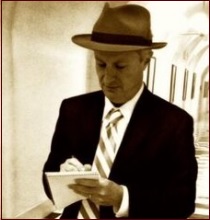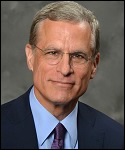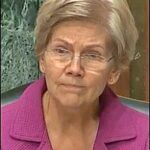By Pam Martens and Russ Martens: May 25, 2023 ~
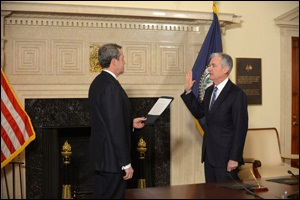
Jerome Powell Is Sworn In As Federal Reserve Chairman on February 5, 2018 by Fed Vice Chairman Randal Quarles. (Official White House Photo.)
Unlike his three immediate predecessors who chaired the Federal Reserve (Janet Yellen, Ben Bernanke and Alan Greenspan), who all had doctoral degrees in economics, the current Fed Chairman, Jerome Powell, has a law degree from Georgetown University.
Given his legal education, one might have expected that when Fed Chair Powell became aware of the largest trading scandal in the Fed’s history in September of 2021, he would have done his legal due diligence to determine where to refer the matter for investigation.
While multiple Wall Street watchdogs called for Powell to refer the investigation to the U.S. Department of Justice and the Securities and Exchange Commission – which conduct all legitimate insider trading investigations involving publicly-traded stocks — the Fed instead referred the investigation on October 4, 2021 to the Federal Reserve Board’s own Inspector General, who is appointed by the Chair of the Fed, reports to the Fed Board (including the Chair) and can be fired by a two-thirds vote of the Fed Board.
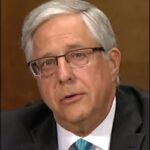
Mark Bialek, Inspector General, Federal Reserve, Testifying at May 17, 2023 Senate Subcommittee Hearing
The Fed Inspector General to whom the investigation was referred is Mark Bialek, who was appointed to the position by Fed Chair Ben Bernanke in 2011, just four days after an explosive audit of the Fed’s emergency bailout programs during and after the 2008 financial crisis was released by the Government Accountability Office (GAO). That audit showed that the Fed had secretly sluiced more than $16 trillion in cumulative loans to the mega banks on Wall Street and their foreign derivative counterparties from December 2007 to at least July of 2010. A statement from Senator Bernie Sanders’ office at the time included the following:
“The Fed outsourced virtually all of the operations of their emergency lending programs to private contractors like JP Morgan Chase, Morgan Stanley, and Wells Fargo. The same firms also received trillions of dollars in Fed loans at near-zero interest rates. Altogether some two-thirds of the contracts that the Fed awarded to manage its emergency lending programs were no-bid contracts. Morgan Stanley was given the largest no-bid contract worth $108.4 million to help manage the Fed bailout of AIG.”
Not to put too fine a point on it, but JPMorgan also played a key role in causing the financial crisis.
The bank holding companies of JPMorgan Chase, Morgan Stanley and Wells Fargo are supervised by the Federal Reserve, as is every other Wall Street mega bank holding company. At the same time, these mega banks are sitting on committees at the New York Fed to determine “best practices” for their industry. See our report: New York Fed’s Answer to Cartels Rigging Markets – Form Another Cartel.
Equally Orwellian, the Federal Reserve Board outsources the role of bank examiners to its regional Fed Banks, which – wait for it – are, literally, owned by the banks being examined, and who get to elect two-thirds of the Board of Directors of their respective regional Fed Bank. See our report: These Are the Banks that Own the New York Fed and Its Money Button.
This Kafkaesque situation resulted in one such bank examiner at the New York Fed, Carmen Segarra, rushing to the Spy Store in lower Manhattan for a tiny microphone to record the bizarre goings on at the New York Fed when she attempted to write a negative bank examination of Goldman Sachs.
On July 11, 2022, Bialek publicly released a letter clearing Fed Chair Powell and former Vice Chair Richard Clarida of violating any “laws, rules, regulations, or policies” for their part in the trading scandal. Bialek’s statement further indicated that “The investigation of senior Reserve Bank officials is ongoing.”
The senior Reserve Bank officials that Bialek is referring to include Robert Kaplan, former Dallas Fed President, and Eric Rosengren, former Boston Fed President. Both stepped down in September 2021 when news of the trading scandal first broke. See our reports: Robert Kaplan Was Trading Like a Hedge Fund Kingpin for Five Years while President of the Dallas Fed; a Dozen Legal Safeguards Failed to Stop Him and Was Boston Fed President Rosengren Trading with Citigroup’s Money?
Powell has repeatedly refused to answer press questions on the matter, stating that the investigation was in the hands of the Inspector General. For example, the following exchange occurred at Powell’s press conference on January 26, 2022, following an FOMC meeting, when Bloomberg News reporter Craig Torres raised the issue:
Torres: “Chair Powell, I have a quick administrative question. You know, Robert Kaplan’s disclosure of his securities transactions: In a couple of months, Chair Powell, or maybe sooner, you and I will file our tax returns. And we’ll list transactions and all kinds of things. And next to those transactions we’ll put dates. And Bloomberg asked for the dates of Mr. Kaplan’s transactions. The Dallas Fed is not giving us the dates. And I don’t see why this is a matter for the Inspector General or anybody else. I mean, why can’t he give us the dates? Will you help us get the dates of those transactions? Thanks.”
Powell: “I know you’ve been all over this issue with my colleagues, Craig, on the issue of information. We don’t have that information at the Board. And, you know, I had — I asked the Inspector General to do an investigation, and that is out of my hands. I’m playing no role in it. I seek to play no role in it. And I don’t — I really — I can’t help you here today on this issue. And I’m sorry I can’t.”
The financial disclosure form that Kaplan and every other Federal Reserve Bank President is required to file clearly indicates that the filer is required to give the month, day and year of each purchase and each sale of a stock or other trading instrument. The form even provides an example of how it wants the date shown, e.g., 2/1/93.
Kaplan was a former CPA with Peat Marwick Mitchell and 22-year veteran of the trading powerhouse Goldman Sachs, where he rose to the rank of Vice Chairman. Kaplan knew, or should have known, that he was evading the prescribed rules of the Federal Reserve system when he substituted the word “multiple” for the specific dates of his trades. Kaplan didn’t do this just on his financial disclosure form for 2020, when the Fed was making unprecedented market interventions during the first year of the pandemic, Kaplan did this on every financial disclosure form that he filed annually from 2015 through 2020. (See Kaplan’s 2015 through 2020 financial disclosure forms here.) And in each of those years Kaplan was, astonishingly, trading in S&P 500 futures contracts, an instrument used typically by hedge funds and other speculators to make highly leveraged bets on the direction of the market.
Every other Fed Bank President and every member of the Fed Board of Governors’ financial disclosure forms for 2020 that we reviewed listed the specific dates of each purchase and each sale of a trading instrument. But Kaplan did not list the dates of his trades for six running years.
Kaplan’s financial disclosure forms suggest that Kaplan maintained a trading relationship with Goldman Sachs, since he lists proprietary products created by “GS,” short for Goldman Sachs.
Wall Street On Parade previously reached out via email to a total of five Goldman Sachs press contacts, inquiring as to whether Kaplan was conducting his “over $1 million” S&P 500 trades and/or his individual stock trades at their firm. (Goldman Sachs’ sophisticated compliance officers should have refused such trades, and certainly in 2020 when Kaplan was a voting member of the FOMC and the Fed was taking unpresented market moving actions throughout the year in response to the pandemic.)
Goldman Sachs declined to answer our questions. The Dallas Fed refused to tell us if Kaplan was using S&P 500 futures to short the market — a bet that the market would go down.
Bialek has been silent on his investigation of Kaplan and Rosengren for more than 19 months now – other than to say that his investigation continues.
New evidence has now emerged that Bialek’s Office of the Inspector General never had the statutory authority to investigate the trading of Fed regional bank presidents in the first place.
Two days ago we sent the following email inquiry to the press office for the Federal Reserve Board’s Inspector General and a similar one to the Federal Reserve Board’s press office. We wrote:
The most recent 2021 Fed Annual Report (as well as previous ones) refer to the reach of the Inspector General of the Fed’s Board of Governors as follows:
“In addition, the OIG conducts audits, evaluations, investigations, and other reviews relating to the Board’s programs and operations as well as to Board functions delegated to the Reserve Banks. Certain aspects of Federal Reserve operations are also subject to review by the Government Accountability Office.”
In addition, in written testimony for the May 17 Senate Banking hearing, an academic scholar on Fed history, Peter Conti-Brown wrote this:
“Congress did create Inspectors General in 1978 to provide some of this oversight. The inspector general for the Federal Reserve, however, is appointed by consultation between the Fed and the CFPB, which shares a single individual inspector general. To be more precise still, this inspector general oversees only the Fed’s Board of Governors, not the Federal Reserve System.” [Bold emphasis added for this article.]
In addition, I found nothing in the Inspector General Act of 1978 (as amended) that gives the Fed Board’s OIG the authority to investigate the privately-owned Fed regional bank presidents’ trading activities.
So my question is, under what statutory authority is the Fed Board’s OIG investigating the trading activities of former Fed Bank presidents?
My deadline is tomorrow, May 24, at 6 p.m. ET.
Best regards,
Pam Martens
Editor, Wall Street On Parade
The press office for the Federal Reserve Board told us our question belonged at the press office for the Inspector General. The press office for the Inspector General cited to Bialek’s July 11, 2022 statement, while ignoring our direct question of: “under what statutory authority is the Fed Board’s OIG investigating the trading activities of former Fed Bank presidents?”
Bialek appeared as a witness at the May 17 Senate Banking Subcommittee on Economic Policy hearing last week. Senator Elizabeth Warren, Chair of the Subcommittee, showed her exasperation with Bialek’s stonewalling, stating as follows:
“You have had a year and a half. You did not call out the trades that we can see. Let us just put it this way, this is not strong oversight. In fact, it is not even competent oversight. It looks like, to anyone in the public, that you gave your boss a free pass, and that’s just not gonna cut it here. And even today, a year and a half later, the Fed continues to stonewall Congress, stonewall the public, on the underlying information about these trades. This is not acceptable. This is why we are pushing for an independent IG.”
Senator Warren has bipartisan support in the Senate to tinker around the edges of the Fed in hopes of reforming it. That includes barring executives from Wall Street mega banks from serving on regional Fed Reserve Bank’s Boards of Directors and making the Fed’s Inspector General a presidentially appointed/Senate-confirmed position.
The American people understand that tinkering is not going to reform what Senator Warren herself calls a “culture of corruption” at the Fed. This culture has become too deeply ingrained over 110 years to be cured by tinkering at the edges.
The place to start with reform is to strip the Fed of any supervisory role of these Wall Street mega banks; strip the Fed of any ability to make trillions of dollars in secret loans to these Wall Street mega banks and their trading casinos; and separate the federally-insured banks from the Wall Street trading casinos by restoring the Glass-Steagall Act, which protected the U.S. from this kind of insanity from 1933 to its repeal in 1999.

